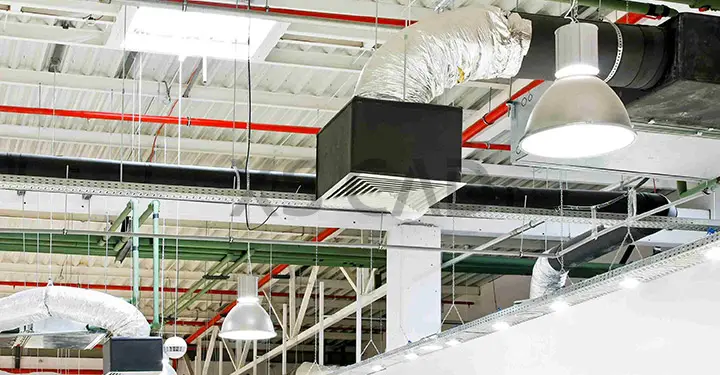Our Articles

The Importance of Hangers & Brackets in MEP Installation
It’s beyond debate. The importance of MEP (mechanical, electrical, plumbing) systems and their components in the construction industry are critical. How these components and systems are placed or fastened to the building premises can define the resulting comfort, functionality, efficiency and safety of the building’s environment. Part of the building’s MEP infrastructure are hangers and brackets, and there are diverse variations of hangers and brackets that support the placement of MEP systems.
Typically, these detailed MEP services are not delivered by building services design consultants as part of their engineering design services. It is usually the MEP contractor who will include hangers and brackets as part of their MEP services/installation sheets.
Ductwork installation during construction can sometimes be a complex procedure and can lead to delays, various challenges and extra unplanned costs when ceiling coordination is not properly designed. More often than it should happen, designers, architects and engineers can underestimate the volume of space required above the ceiling for ductwork, electrical conduits, fire protection and plumbing pipes, leading to a coordination fiasco during construction.
After beams, columns and slabs (main structural members) are erected on site, building services components are fastened on to the structure, so that any alignment irregularities can be eliminated. So, how are these services and their components installed?
Typically, heavy HVAC ducts, electrical conduits and plumbing and firefighting pipes are either positioned on a horizontal support or suspended from the ceiling, supported every two to three metres. The horizontal support consists of steel channel sections fastened with clamps or baseplates, depending on the beam or column’s material. In the case of suspended support, anchors are drilled into the concrete and threaded rods can be inserted, or steel angle channel sections can be welded together and fastened to structural members.
For lighter HVAC ducts, cable trays, lighting panels and pipe supports, steel wires bundled together are joined to internally threaded concrete drop-in anchors using a threaded bolt and hook, which then form a loop around the tray, pipe or duct.
There are 3 key challenge to these support systems, namely:
1. Complex and lengthy process – the slotted or welded channels lead to material wastage and the need for skilled welders
2. Decreased productivity – difficult to mark, align and anchor these supports, difficult to modify in case of misalignment
3. Lack of system approval – frames, supports and anchors lack approval, as anchors for welding frames into concrete have no approval for cracked concrete, due to thermal shrinking, creep, etc. The frame may not be approved for fire and seismic factors.
There is every chance that MEP fastenings which are not approved may fail and cause building services to collapse during fires and earthquakes, causing loss of life.
An ideal support system will consist of:
A wire-hanging system, or hangers, combines anchors and frames in a solution approved by authorised assessors, is attractive, light, supplied in ready-to-use kits for easy installation and can leverage the support of field teams. This system consists of an anchor, a thick wire loop with a stud, an i-bolt, a keyless blocker to lock the wire in place, snap hooks, corner protectors for HVAC ducts and protective sleeves.
This hanger system can support cable trays, HVAC ducts, light fixtures and supports for mechanical pipes (up to a load of 300kg per support). The system is flexible enough to enable ceiling suspended services that are installed up to 60 degrees from the vertical.
During MEP design, the volume of space needed to route building services between the ceiling and overhead floor levels needs careful consideration. Clients push to maximise floor to ceiling heights, but the above-ceiling space is rarely considered. This results in cramped spaces for building services installation. It is important that architects, MEP designers and engineers understand hangers and support systems to coordinate during the design phase so that the right volume of space is provided for MEP services. Effective communication is equally relevant at this point.
Factors to consider while determining above-ceiling space requirements include the following:
Traditionally, this placement has been planned on approximate sizing and spacing based on experience that may or may not comply with building code guidelines.
Advances in modern software tools have made the design and placement of MEP components easier. For instance, Revit’s plug-in, DeWalt Corporation Hanger Design, can help automate the design and placement of hangers and trapeze assemblies for ducts, pipes, conduits and cable trays.
Revit’s MEP Hangers can separate ducts, pipes, cable trays and conduits into defined lengths as required and can mark MEP components for fabrication. Bills of materials and shop drawings can be generated for accurate on-site assembly.
Revit, specially created as a BIM (building information modelling) software, offers several advantages for consolidation of parallel runs and placement of hangers. The systems are analysed, and trapeze assemblies, hangers and anchors are placed automatically and in accordance with building codes. Engineering calculation reports are generated, and product data is placed in the model. Useful activities that are part of the MEP BIM process become simple using Revit.
Other features of Revit’s MEP Hangers include the following:
Powerful features:
Efficiency
Compliance
Brackets, or pre-cut metal channels, are also used to support MEP systems, namely electrical containment, pipes and other services.
Advantages of using brackets include the following:
There are several types of brackets available for use in MEP systems. Two of the more commonly used types of brackets are the low-profile bracket and the universal bracket. When are they more often used and why?
Low Profile Bracket
Universal Bracket
Ultimately, the inclusion of hangers and brackets is an integral part of MEP BIM services. Trusted MEP contractors, and not building services design consultants, will deliver high-quality building services coordination and other engineering design services with accurate representations of hangers and brackets, which have a significant and defining role in MEP services.

